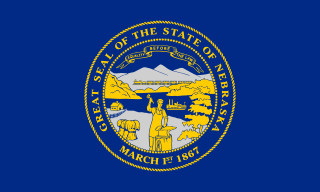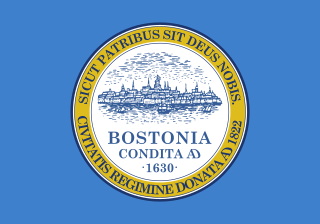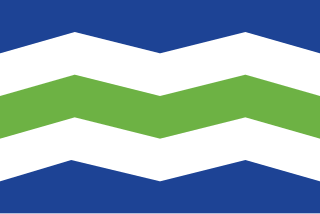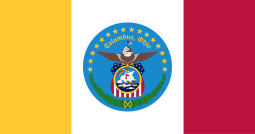
The national flag of the Netherlands is a horizontal tricolour of red, white, and blue. The current design originates as a variant of the late 16th century orange-white-blue Prinsenvlag, evolving in the early 17th century as the red-white-blue Statenvlag, the naval flag of the States-General of the Dutch Republic, making the Dutch flag the oldest tricolour flag in continuous use. As a flag that symbolises the transformation from monarchy to republic, it has inspired both the derivative Russian flag, and after the French Revolution in 1789, the vertically striped French tricolour; both flags in turn influenced many other tricolours. During the economic crisis of the 1930s, the old Prince's Flag with the colour orange gained some popularity among some people. To end the confusion, the colours red, white and blue and its official status as the national flag of the Kingdom of the Netherlands were reaffirmed by royal decree on 19 February 1937.

The flag of Missouri, often referred to as the Missouri flag, is the state flag of the U.S. state of Missouri. It consists of a triband of three equal horizontal stripes colored red, white, and blue, with the arms from the Great Seal of Missouri in the center. Designed by Mary Elizabeth Oliver, the red and white stripes represent valor and purity, respectively. The blue stripe represents the permanency, vigilance, and justice of the state. The three colors also highlight the French influence on the state in its early years. The Missouri flag was established on March 22, 1913, when governor Elliot Woolfolk Major signed the State flag act making it official.

The Ohio Burgee is the official flag of the U.S. state of Ohio. It is a triangular swallowtail flag. Its red, white, and blue elements symbolize the state's natural features and order of admission into the Union. A prominent disc in the flag's triangular canton is suggestive of the state's name. The flag was adopted in 1902.

The national flag of Spain, as it is defined in the Constitution of 1978, consists of three horizontal stripes: red, yellow and red, the yellow stripe being twice the height of each red stripe. Traditionally, the middle stripe was defined by the more archaic term of gualda, and hence the popular name la Rojigualda (red-weld).

The Beehive Flag is the official flag of the U.S. State of Utah. It is a horizontal tricolor with irregular bands of blue, white, and red. The middle white band contains a blue hexagon outlined in gold. Within the hexagon lies a gold-colored beehive, and below it sits a five-pointed white star.
A triband is a vexillological style which consists of three stripes arranged to form a flag. These stripes may be two or three colours, and may be charged with an emblem in the middle stripe. All tricolour flags are tribands, but not all tribands are tricolour flags, which requires three unique colours.

The flag of Nashville, Tennessee, consists of the city's seal on a white disc surrounded by a field of blue, with a strip of gold on the fly. According to the resolution adopting the flag, the blue stands for the courage and conviction of the city's leaders throughout history, while the gold denotes the richness of city's land and resources. The flag was adopted in December 1963 when the governments of Nashville and Davidson County merged to form the Metro government. In an official ceremony, it was reigned in as the new flag on August 4, 1964, at the Metropolitan Courthouse. The flag is modeled after the Tennessee state flag.

The flag of Birmingham was designed by Idyl King Sorsby for the occasion of the semicentennial of the city of Birmingham, Alabama in 1921. The flag was officially adopted as the city's flag on August 18, 1925.

The city flag of Philadelphia is a blue and yellow triband, featuring the Seal of Philadelphia.

The flag of the state of Nebraska is a blue rectangular cloth charged with a variation of the Nebraskan state seal. The current design was commissioned in 1925, when the Nebraska legislature passed a bill stating that the flag would consist of the state seal in gold and silver on a field of blue.

The state flag of Berlin, Germany has three stripes of red-white-red, the two outer stripes each occupying a fifth of its height, the middle the remaining three-fifths. It is emblazoned with a bear on the civil flag, while it bears the coat of arms of Berlin on the state flag.

The flag of the president of the United States consists of the presidential coat of arms on a dark blue background. While having the same design as the presidential seal since 1945, the flag has a separate history, and the designs on the flag and seal have at different times influenced each other. The flag is often displayed by the president in official photos, or flown next to the casket of a former president in official funeral processions, and flown on the president's motorcade. The flag is not flown at half-staff since there is always an incumbent president in office. The current flag is defined in Executive Order 10860:
The Color and Flag of the President of the United States shall consist of a dark blue rectangular background of sizes and proportions to conform to military and naval custom, on which shall appear the Coat of Arms of the President in proper colors. The proportions of the elements of the Coat of Arms shall be in direct relation to the hoist, and the fly shall vary according to the customs of the military and naval services.

The flag of Boston consists of a sky blue field and the seal of the city of Boston, Massachusetts, United States, in the center. The flag is sometimes flown in a darker shade of blue, more of a turquoise. It was designed in 1913 and adopted by the Boston City Council on January 29, 1917.

The flag of Batangas is the provincial flag of Batangas, Philippines. It is a horizontal triband of blue, white, and red — the main colors of the Philippine flag — with the escutcheon taken from the provincial seal in the center.

The flag of Knoxville, Tennessee, was officially adopted by municipal ordinance on October 16, 1896. It is the third oldest official city flag in the United States and the oldest flag of any state or city governmental entity in Tennessee.

The flag of San Jose is the official municipal flag of San Jose, California. The current design, a triband of gold on top, white in the middle, and blue on the bottom with the city's official seal in the center, has been the official flag since 1984.

The flag of Austin is the official municipal flag of Austin, Texas. The flag simply consists of a white field with the seal of Austin without the surrounding circle of text. Below the seal of Austin is the text "CITY OF AUSTIN", written in blue and arched upwards.

The flag of Raleigh is the official municipal flag of Raleigh, North Carolina. It is one of the few American city flags to currently feature different designs on the obverse and reverse. Both sides feature a similar red-white-red vertical triband with an emblem in the center. The obverse features the Seal of Raleigh. The reverse has a modified version of the coat of arms of Sir Walter Raleigh.

The flag of Dayton, Ohio, U.S., was adopted on December 15, 2021, and created by Dayton design and marketing firm Catapult Creative. The cost to the city for the design and an accompanying video was $4,300.

The flag of Burlington, Vermont was adopted by the Burlington city council on November 27, 2017 during the mayorship of Miro Weinberger. It is five horizontal, zig-zag stripes of blue, white, green, white, and blue.
























